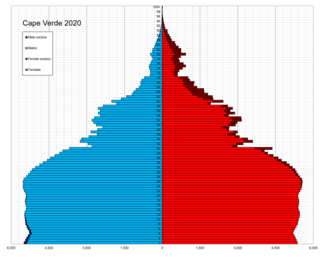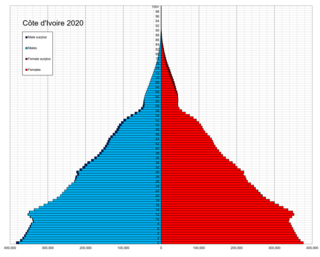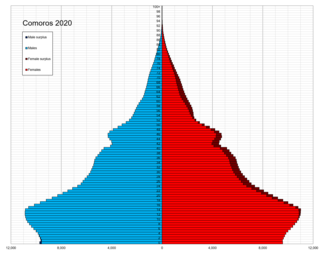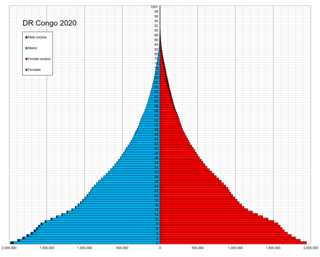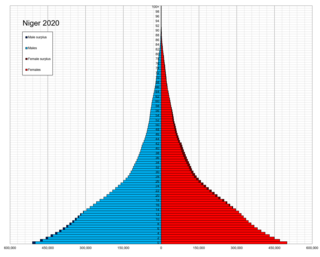| Demographics of Benin | |
|---|---|
 Population pyramid of Benin in 2020 | |
| Population | 13,754,688 (2022 est.) |
| Growth rate | 3.34% (2022 est.) |
| Birth rate | 41.15 births/1,000 population (2022 est.) |
| Death rate | 8.01 deaths/1,000 population (2022 est.) |
| Life expectancy | 62.21 years |
| • male | 60.39 years |
| • female | 64.14 years |
| Fertility rate | 5.43 children born/woman (2022 est.) |
| Infant mortality rate | 55.76 deaths/1,000 live births |
| Net migration rate | 0.24 migrant(s)/1,000 population (2022 est.) |
| Age structure | |
| 0–14 years | 45.56% |
| 65 and over | 2.39% |
| Sex ratio | |
| Total | 0.97 male(s)/female (2022 est.) |
| At birth | 1.05 male(s)/female |
| Under 15 | 1.02 male(s)/female |
| 65 and over | 0.72 male(s)/female |
| Nationality | |
| Nationality | Beninese |
| Language | |
| Official | French |

The demographics of Benin include population density, ethnicity, education level, health of the populace, economic status, religious affiliations and other aspects of the population.
Contents
- Population
- Vital statistics
- Fertility and births
- Life expectancy
- Ethnic groups
- White Beninese
- Other demographic statistics
- Population 2
- Religions
- Age structure
- Total fertility rate
- Median age
- Population growth rate
- Birth rate
- Death rate
- Net migration rate
- Mother's mean age at first birth
- Contraceptive prevalence rate
- Urbanization
- Sex ratio
- Life expectancy at birth
- Contraceptive prevalence rate 2
- Children under the age of 5 years underweight
- HIV/AIDS
- Major infectious diseases
- Nationality
- Ethnic groups 2
- Religions 2
- Languages
- Literacy
- Education expenditure
- References
The majority of Benin's 13.3 million people live in the south. [1] [2] The population is young, with a life expectancy of 62 years. [1] [2]
About 42 African ethnic groups live in this country; these various groups settled in Benin at different times and have also migrated within the country. [2] Ethnic groups include:
- the Yoruba in the southeast (migrated from what is now Nigeria in the 12th century); [2]
- the Dendi in the north-central area (they came from what is now Mali in the 16th century); [2]
- the Bariba and the Fula (or Fulani) (Fula : Fulɓe; French : Peul) in the northeast; [2]
- the Betammaribe and the Somba in the Atacora Range; [2]
- the Fon in the area around Abomey in the South Central; [2] and
- the Mina, Xweda, and Aja (who came from what is now Togo in the 12th century) on the coast. [2]
- the Ewe people on the coast
French is the official language but is spoken more in urban than in rural areas. [2] The literacy rate is 54% among adult males and 31% among adult females as of 2018; [1] these rates are slowly growing.[ citation needed ] Recent migrations have brought other African nationals to Benin, including Nigerians, Togolese and Malians. [2] The foreign community also includes many Lebanese and Indians involved in trade and commerce. [2] The personnel of the many European embassies, foreign aid missions, nongovernmental organizations and missionary groups account for much of the 5,500 European population. [2]
Several religions are practiced in Benin. [2] Traditional African religions are widespread (50%), and their practices vary from one ethnic group to the other. [2] Arab merchants introduced Islam in the north and among the Yoruba. [2] European missionaries brought Christianity to the south and central areas of Benin. [2] Muslims account for 20% of the population and Christians for 30%. [2] Many nominal Muslims and Christians continue to practice traditional African religion traditions. [2] It is believed that West African Vodun originated in Benin and was introduced to Brazil and the Caribbean Islands by slaves taken from this particular area of the Slave Coast. [2]






